Railway signalling in Britain was originally based on the operation of 2-aspect semaphore signals by a single wire and operation of points using rodding. This blog has an (incomplete) series of articles about these techniques, starting at Railway Signalling in Britain: Part 1: Introduction.
In continental Europe and its export markets, a completely different approach developed using double wires kept under tension to control each semaphore signal and each set of points. This technique was usually employed with a type of lever frame described as 'Turnover'.
The double wire approach conferred some advantages, most importantly allowing points to be operated at greater distances from the signal box than using rodding and allowing semaphore signals provided one or two arms to be controlled from one double wire. A further potential advantage compared with single-wire operation of signals is that, with single wire operation, the first part of the lever movement may be 'wasted' in taking up the slack. Similarly, if the bell cranks in point rodding runs become worn, that results in 'lost motion' of the lever. Because both wires in the double-wire approach are maintained in tension by Compensators, 'lost motion' is eliminated.
There's an excellent 'primer', written in 2004 by Dr James B. Calvert, here.
The 1932 book ‘Lewis’s Railway Signal Engineering (Mechanical)’ (book reference [1] below) has a chapter on Double Wire Working which you can read here.
Details of design and signal aspects displayed vary from country to country. The paragraph below applies to Poland.
Signal arms project to the right of the post (rather than to the left as in Britain) and arms have a distinctive shape and colouring.Thailand
In a signal provided with one arm (often used for 'starting' or 'departure' signals) the arm stands horizontal for 'stop' and is raised to an angle of 45 degrees for 'proceed'.
In a signal provided with two arms (often used for 'home' or 'entrance' signals) the upper arm stands horizontal and the lower arm stands vertical for 'stop'. 'Proceed at line speed' is indicated by raising the upper arm to an angle of 45 degrees and maintaining the lower arm vertical. 'Proceed at reduced speed' (for instance, entering a loop line) is indicated by raising the upper arm to an angle of 45 degrees and lowering the lower arm to an angle of 45 degrees.
At night, coloured lights are displayed through moveable spectacles.
My first experience of double wire working of points and signals was when my firm supplied equipment for a Train Despatcher system in Thailand. I made a number of visits to the country during the installation and commissioning phase. Most of the signalling installations were double wire, controlled from distinctive Turnover Frames. At one signal box (Hua Hin, I think), the smiling signalman let me work the frame between trains to my heart's content. I was fascinated with levers which turn through 180 degrees, where the tip of the lever is moved through an arc of over seven feet. Viewed from the left of the frame, the lever arc is from about "11 o'clock" to "5 o'clock" Having been brought up on Mr. Webb's frames for the London and North Western Railway with 'hoop' catch handles, I found Turnover Frames very odd. Having pulled the lever to about the "2 o'clock" position, you then need to reverse your grip on the handle so that you can push it down to the "5 o'clock" position. The signals were of the 'German' upper quadrant pattern, common in Europe and further afield, where the signal post and arm design is very different from British practice and, most confusingly, when viewed from the front, signal arms extend to the right of the post.
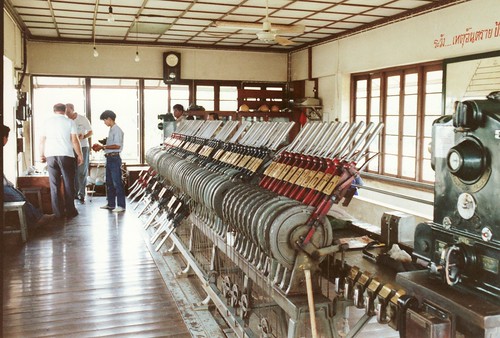 A Signalbox with a large Turnover Lever Frame.
A Signalbox with a large Turnover Lever Frame.
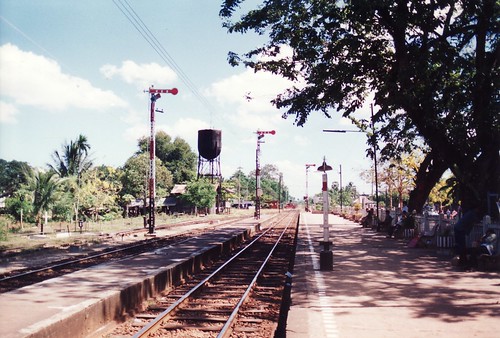 Three semaphore 'starting' signals at a wayside station.
Three semaphore 'starting' signals at a wayside station.
After the Train Despatcher project was completed in 1989, I returned to Bangkok to assist in setting up Bangkok Railway Museum and I arranged for a small Turnover Frame to be exhibited, along with a pair of Electric Token machines, representing a wayside station. There's a short post about the setting up of the Bangkok Railway Museum here, with links to pictures.
Poland
In 2003 I accompanied my friend Mike to Poland for steam locomotive driving on 'The Wolsztyn Experience', briefly described here. Out in the country, most signals were semaphore of the 'German' pattern, although colour-lights prevailed where we joined the main lines at Posnan, Zybasyn and Lesno. I was able to have a good look at the turnover frame at one of Wolsztyn's two signalboxes.
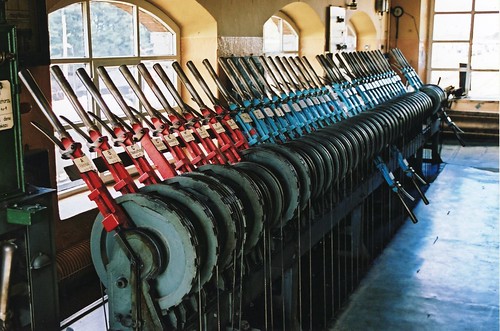 Wolsztyn Signalbox: Detail of Turnover Lever Frame.
Wolsztyn Signalbox: Detail of Turnover Lever Frame.
 A row of semaphore signals at Wolsztyn. The black metal box displaying a diagonal white marking is a mechanical point indicator.
A row of semaphore signals at Wolsztyn. The black metal box displaying a diagonal white marking is a mechanical point indicator.
Indonesia
Visiting Yogyakarta, Java in 2010, I made a brief visit to Maguwo station which has semaphore signals and points controlled using the double wire system from a turnover frame. Signals were similar to the 'German' pattern but the arc of the levers in the Turnover Frame (viewed from the left) was restricted, extending from "12 o'clock' to "5 o'clock". There's a brief report here.

Part of the Turnover Frame at Maguwo, Indonesia.
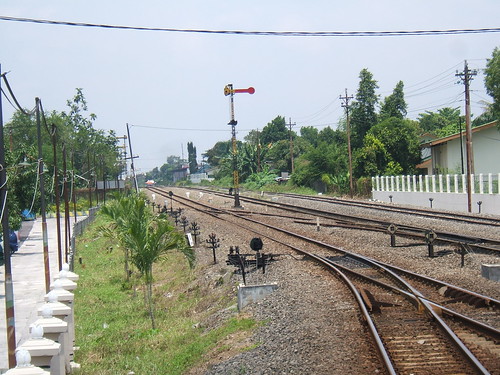 Maguwo: Single arm 'starting' signal with two arm 'home signal' just visible left background. Note the point indicators and point/signal wires carried on pulleys
Maguwo: Single arm 'starting' signal with two arm 'home signal' just visible left background. Note the point indicators and point/signal wires carried on pulleys
Russia
On my trips to Russia, I only found colour light signals in use but at the Rolling Stock Museum, Novosibirsk (which I visited in 2012 as part of a trip from Ulaan Baatar to Moscow, described here), I found a very Germanic-looking 2-arm 'Entrance' signal with a Signal Cam Wheel mounted on the post.
 Click on image for larger view
Click on image for larger viewUpper part of a 2-arm home signal, showing the post-mounted Signal Cam Wheel operating both arms through push rods.
Vietnam
On my second visit to Vietnam as part of my 'Far East 6' trip in 2013 (described here), I was able to see a little more of the railways which mainly feature colour light signals. But in places I found semaphore, double-wire operated signals, as shown below. However, these were lower quadrant arms, extending to the left of the post. The front of the arms was red and white and they would have looked almost British, apart from generally having two 'stop' arms, one of which was usually hanging straight down. I presume turnover frames controlled these mechanical installations but I didn't have an opportunity to confirm this.
 Click on image for larger view
Click on image for larger viewLower arm of a 2-arm 'Entrance' signal, showing the post-mounted Signal Cam Wheel operating both arms through push rods.
China
In 2013, I travelled to Tibet by train from China: the journey is described in the post Travelling on the Qinghai - Tibet Railway. As expected, all the railway signals were colour light. Then I had a couple of days in Shanghai and, in Shanghai Railway Museum, I found a 2-arm semaphore signal similar in appearance to those in use in Vietnam. However, the Chinese example had two escapement mechanisms near the base of the post rather than a conventional Signal Cam wheel so I'm not certain it was intended for double wire operation.
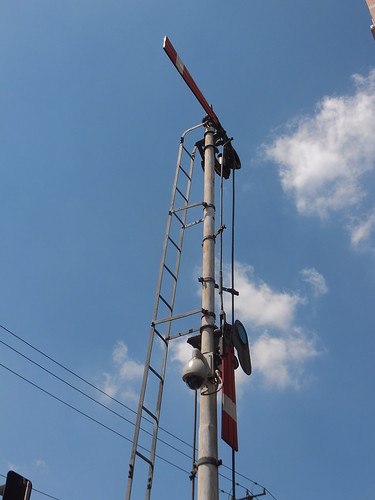
A preserved 2-arm 'home' signal from the Tai Yuan Railway Administration, now on display at Shanghai Railway Museum (complete with CCTV camera).
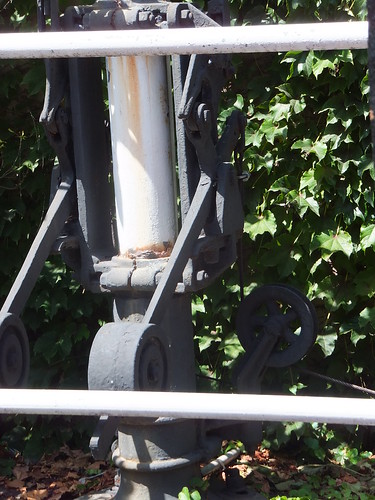
Detail of escapement mechanism at the base of the post.
Britain
The Board of Trade did not permit operation of points using rodding which were more than 350 yards from the controlling lever frame. The use of double-wire operation of points was not authorised until 1925, after which a few installations were made, either as complete turnover frames or simply as a short extension to a conventional lever frame.
Rowsley Down Sidings had one of the early LMS non-interlocked turnover frames - a rather crude affair where a counterweight near the end of each lever held it 'normal' or 'reverse'. In this design, the arc of the levers in the frame (viewed from the left) was from "10 o'clock' to "3 o'clock". There's a picture on Dominic Beglin's page Old Pictures Part 1. The LMS then produced a more refined frame design called the 'LMS New pattern Turnover Frame'. There's a description of some of the LMS double-wire initiatives on Dave Harris's Derby Signalling Web Site page Cottage Lane Crossing. Barrow Hill Up Sidings Box also used this pattern frame and there are more details on the indispensible site 'The Signal Box' here. When Barrow Hill Up Sidings Box was abolished, its Turnover Frame was preserved by the National Railway Museum. Apparently, both the Great Western Railway and the London & North Eastern Railway Railway had a few Turnover Frames.
Peak Rail
Peak Rail have a project in hand to install a Midland-pattern signal box at the present northern terminus, Rowsley, to control the points at the north end of the station. This will feature double-wire operation from a frame of the 'LMS New pattern Turnover' design (part of the Barrow Hill Up Sidings Turnover Frame mentioned above) housed in the structure from Bamford Signalbox (relocated again). Progress on this project is shown on Dominic Beglin's page Latest Project News. There's also a discussion thread on 'The Signal Box' site here.
Related articles on other sites
Two-Wire Transmission.
Double Wire installations in Australia (A very detailed article by Andrew Waugh).
The Signal Page (Information on signalling practice in many countries).
Book references
[1] ‘Lewis’s Railway Signal Engineering (Mechanical)’ revised and enlarged by J H. Fraser (Constable & Company Ltd. 3rd edition 1932).
[2] 'Modern Railway Signalling' by Tweedie and Lascelles (Blackie and Son Ltd 1925).
My pictures
Railways in Thailand (1989).
Polish Railways (PKP).
Java: Maguwo Station.
Railways in Vietnam.
Shanghai Railway Museum.
